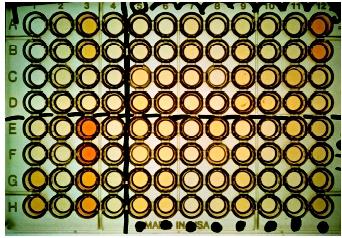Antibodies in Research
Antibodies are proteins made by B cells, part of the body's immune system. The normal function of antibodies is to latch onto foreign substances (antigens) and flag them for destruction, thus helping to fight infection. This ability to bind to specific molecules makes them ideal probes in cell research, where they are used to latch onto, and thus help isolate and identify, molecules of interest in and on cells. Antibodies have become one of the most important tools for studying protein function in cells.
To see how antibodies are used, consider the challenge of determining where actin is located in a nerve cell. Actin is a protein that forms part of the cytoskeleton , giving internal structure to the cell much like the human skeleton does. First, purified actin is used to trigger an immune reaction in a rabbit. The B cells that make the anti-actin antibodies are then isolated

Next, in order to make the antibodies visible once inside the cell, a fluorescent molecule is attached to them. They are then injected into the cell using a very fine glass needle. Once an antibody encounters actin, it attaches to it. The cell can then be examined under the light microscope, where the fluorescent molecules will light up, revealing the location of the actin. Of course it is not just actin that can be found this way; any protein to which we can make an antibody can be located in the cell.
Several modifications and extensions of this basic procedure are possible. To mark more than one protein at a time, a set of different antibodies is used, each marked with a differently colored fluorescent tag. In this way, for instance, the spatial relations between actin and other cytoskeleton proteins can be visualized. Instead of fluorescent tags, antibodies can be attached to gold particles, which will show up under the electron microscope. Outside of cells, antibodies attached to glass beads can grab proteins out of a homogenized cell puree, allowing the protein to be isolated for further study. In one widely used technique called western blotting, fluorescently tagged antibodies are used to locate proteins of interest that have been separated in electrophoresis gels.
Antibodies are also used in a test, or assay, called the enzyme -linked immunosorbent assay (ELISA). This is the assay used in the home pregnancy test, which detects the presence of human chorionic gonadotropin (HCG), produced by human embryos. The test kit contains an antibody to HCG, which traps HCG if it is present in a woman's urine. Next, a second antibody to HCG is added, which will bind to the HCG if it is trapped. This antibody is linked to an enzyme called peroxidase. Chemicals are then added which the peroxidase will cause to react, making a color change. The color change will only occur if the enzyme is present, and the enzyme will only be present if the HCG is present. Therefore, a color change indicates pregnancy. An ELISA test is also used to screen for HIV (human immunodeficiency virus) infection. In this case, the test kit contains HIV proteins, which bind to anti-HIV antibodies in the patient's blood.
It is the specificity of the antibody-antigen reaction, combined with the ability to link one or the other to fluorescent tags, enzymes, or other markers, that makes antibodies such versatile tools in both basic and clinical research.
SEE ALSO Antibody ; Clone ; Cytoskeleton ; Electrophoresis ; Female Reproductive System
Richard Robinson
Bibliography
ELISA at the Biology Project. <http://www.biology.arizona.edu/immunology/activities/elisa/main.html> .
Roitt I., D. Male, and J. Brostof. Immunology, 5th ed. New York: Mosby, 1998.
YALOW, ROSALYN SUSSMAN (1921–)
U.S. biologist who developed a technique, called "radioimmunoassay," for detecting and measuring tiny amounts of biological substances using radioactive antibodies. Her technique led to enormous numbers of medical breakthroughs, but most notably it opened up the entire field of endocrinology, the study of hormones. Dr. Yalow was awarded the 1977 Nobel Prize in medicine for her research.
Thursday, November 01, 2018
Cell therapy is the transplantation of human cells to replace or repair damaged tissue and/or cells, spanning from blood transfusion to CAR-T cell therapy and from treating cancer and hematologic conditions to autoimmune disease, infectious disease, metabolic disorders, and many more applications. The origin of the cells can be from the patient themselves (autologous) or from a donor (allogenic).
Cell therapies represent an exciting and complex new treatment paradigm, with the potential to treat an enormous range of indications, and in some cases offer the possibility of a cure with only a single treatment.
As of today, there are 6 FDA-approved and marketed cell therapies in the US.
Carticel - Vericel Corp
Gintuit - Organogenesis Inc
Kymriah - Novartis Pharmaceuticals Corp
Maci - Vericel Corp
Provenge - Dendreon Pharmaceuticals LLC
Yescarta - Kite Pharma Inc (Gilead)
Cell therapy manufacturing is still nascent and many manufacturers are utilizing time, space, and labor-intensive techniques that are practical for current volumes but are currently developed to scale for commercial volume and larger patient groups in the future. However, decentralization, proximity to hospitals, and boutique manufacturing for clinical phase I, I/II trials, and for ultra-rare indications will maintain a healthy and flexible niche market for small CDMOs.
Indeed, the current cell therapy contract manufacturing space is fragmented between small contractors including medical centers and big players such as, Wuxi AppTec, Lonza, GE Healthcare. Such big players are heavily invested in capacity building to support the prospective cell therapy pipeline.
Of that current cell therapy pipeline, most candidates are preclinical or in Phase II.